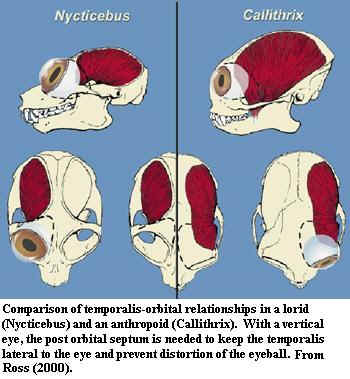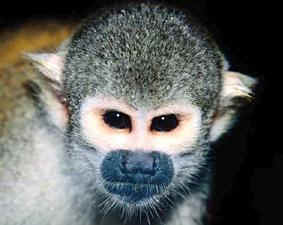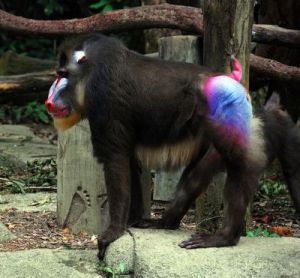 Anthropoidea : Texans > tarsiers [R00]. Some workers use a crown group definition, excluding the "Eosimiidae" and some other extinct groups. Afrotarsus, Bahinia, Eosimias.
Anthropoidea : Texans > tarsiers [R00]. Some workers use a crown group definition, excluding the "Eosimiidae" and some other extinct groups. Afrotarsus, Bahinia, Eosimias.| Primates | ||
| The Vertebrates | Anthropoidea |
| Vertebrates Home | Vertebrate | Vertebrate |
|
Abbreviated Dendrogram
Archonta
│
└─Primates
├─Strepsirhini
└─Haplorhini
├─Tarsiiformes
└─Anthropoidea
├─Platyrrhini
└─Catarrhini
├─Cercopithecidae
└─Hominoidea
├─Hylobatidae
└─Hominidae
├─Ponginae
└─Homininae
|
Contents
Overview |
Taxa on This Page
 Anthropoidea : Texans > tarsiers [R00]. Some workers use a crown group definition, excluding the "Eosimiidae" and some other extinct groups. Afrotarsus, Bahinia, Eosimias.
Anthropoidea : Texans > tarsiers [R00]. Some workers use a crown group definition, excluding the "Eosimiidae" and some other extinct groups. Afrotarsus, Bahinia, Eosimias.
Range: from the Middle Eocene, probably earlier.
Phylogeny: Haplorhini : Tarsiiformes + * : Platyrrhini + Hominoidea.
Characters: consistent trend to higher body weights [R00]; orbits highly convergent [R00]; orbits vertically oriented (related to having acute, overlapping fields covering range of action of forelimbs) [R00]; cornea with small diameter [R00]; eyes with high concentrations of cones & ganglion cells [R00] [2]; fovea present (synapomorphy of Haplorhini) [R00]; eyes with extreme magnification of foveal and parafoveal regions of the visual field in the visual cortex [R00]; $ retinal blood vessels absent from fovea [R00]; visual rods excluded from fovea (except Aotus) [R00]; unique eye shape emphasizing visual acuity over light-gathering capability [R00]; probably trichromatic vision (3 visual pigments differing in peak absorption wavelength) [R00]; changes in orbit orientation shifts origin of anterior temporal muscles anteriorly, & postorbital septum required to prevent distortion of eyeball [R00]; middle ear with anterior accessory cavity if the petrous temporal bone enhances hearing at low frequencies) [R00]; further increase in brain size and particularly in neocortex [R00]; superficial masseters vertically oriented [R00]; mandibular symphysis fused [R00]; incisors vertically planted & spatulate [R00]; long power stroke in chewing cycle [R00]; well-developed Phase II wear facets on molars (see diagram at left) [R00]; primitively frugivorous & insectivorous, probably arboreal leapers [R00]; unusually long-lived.
 Notes: [1] [R00] argues that anthropoid origins are related to shift from small nocturnal predator to large diurnal omnivore. Became diurnal first. [2] Cones are the visual receptors specialized for color and visual acuity. They operate best at high light levels. Cones transmit information to the visual cortex via ganglion cells. As one might expect, the lower the ratio of cones to ganglion cells, the higher the visual acuity. Anthropoids have an unusually low ratio. This measure actually understates the degree of visual specialization, because anthropoids have a strongly disproportionate number of ganglion P-cells which register color and shape, as compared to the ganglion M-cells, which register contrast and movement.
Notes: [1] [R00] argues that anthropoid origins are related to shift from small nocturnal predator to large diurnal omnivore. Became diurnal first. [2] Cones are the visual receptors specialized for color and visual acuity. They operate best at high light levels. Cones transmit information to the visual cortex via ganglion cells. As one might expect, the lower the ratio of cones to ganglion cells, the higher the visual acuity. Anthropoids have an unusually low ratio. This measure actually understates the degree of visual specialization, because anthropoids have a strongly disproportionate number of ganglion P-cells which register color and shape, as compared to the ganglion M-cells, which register contrast and movement.
Links: Anthropoidea; subordo Anthropoidea; anthropoids; Affen; Faculty - Lecture #15; The BC200 RNA Gene and Its Neural Expression Are Conserved in ...; Primate Taxonomy; Lecture 2 Primate taxonomy; Primates - Introduction French).
References: Ross (2000) [R00]. ATW021109.

Platyrrhini: "New World monkeys", including marmosets, tamarinds, titis, capuchins, squirrel monkeys, sakis, uacaris, and howling monkeys, etc. Spider monkeys > Spider Man.
Range: from the Oligocene. Originated in South America. Currently in South and Central America.
Phylogeny: Anthropoidea : Catarrhini + *.
 Characters: nostrils large, separated by wide septum; orbital septum complete; zygomatic contacts parietal; ear without ectotympanic tube; dental formula 2/1, 1/1, 3/3, 2-3/2-3; tails prehensile; limited development of opposable digits; opposable digit 5, not 1 (??); quadrupedal; entirely arboreal; infants carried dorsally; scent marking common with scent glands.
Characters: nostrils large, separated by wide septum; orbital septum complete; zygomatic contacts parietal; ear without ectotympanic tube; dental formula 2/1, 1/1, 3/3, 2-3/2-3; tails prehensile; limited development of opposable digits; opposable digit 5, not 1 (??); quadrupedal; entirely arboreal; infants carried dorsally; scent marking common with scent glands.
Images: (right) from Infraorder Lemuriformes Suborder Strepsirhini Infraorder ... left) Saimiri sciureus from primates.com - monkeys - uakari, showing the typical platyrrhine nose.
Links: platyrrhine monkeys; Platyrrhini; Platyrrhini; platyrrhini; newworldmonkeyinfopage; The Primates- Monkeys; Sub-Unit- Infraorder Platyrrhini; Parte 02 Portuguese); human3 (German); Platyrrhine Molecular Datasets. ATW021110.
Papio hamadryas (hamadryas baboon) eating an apple. Fruit is not a regular part of its diet in the wild. This photo shows the distinctive, downward pointing, catarrhine nose. Photo by LadyofHats, via Wikipedia, Public Domain |
Catarrhini : old world monkeys, apes, humans.
Range: from the Oligocene
Phylogeny: Anthropoidea : Platyrrhini + * : Cercopithecidae + Hominoidea + *.
Alpha male Grey Langur at Mudumalai National Park. Photo by Marcus334 via Flikr and Wikipedia, Creative Commons Attribution Share Alike, GNU Free Documentation |
 Male Mandrill (Mandrillus sphinx (Linnaeus, 1758)) at Singapore Zoo, showing the extraordinary colouration. Photo by Robert Young via Flikr and Wikipedia, Creative Commons Attribution |
Comments: The Catarrhini are one of the two main clades of higher primates (the Anthropoidea or "human-like"), the other being the Platyrrhini. Technically, the distinction of catarrhines from platyrrhines depends on the structure of the nose. The name Catarrhini means drooping or downward nose, and refers to their narrow, downward pointing nostrils, in contrast with the outward or sideways pointing nostrils of the New World monkeys (Platyrrhini). Other distinctions include both a tubular ectotympanic (ear bone), and eight, not twelve, premolars in catarrhines. The Catarrhini themselves are divided into two main clades, the Cercopithecidae or Old World monkeys and Hominoidea or apes (including man), who is a hairless upright ape). The distinction of Old World monkeys from apes depends on the shape of the teeth, and, usually, the presence or absense of a tail. Both these groups evolved from a common ancestor such as Aegyptopithecus from the early Oligocene Fayum of Egypt (the contemporary Propliopithecus may or may not be synonymous, if it is, Aegyptopithecus has to be re-named Propliopithecus because the latter is the earlier name) MAK120708 , incorporating Wikipedia
Links Meet an Ancestor: Propliopithecus chirobates
Cercopithecidae : Old World monkeys
Range: from the Miocene of Europe, Africa, and Asia
Phylogeny: Catarrhini : Hominoidea + *.
Comments: (adapted from Wikipedia) Old World monkeys include many of the most familiar species of nonhuman primates, such as baboons and macaques. They are generally medium to large in size, and include both arboreal forms, such as the colobus monkeys, to fully terrestrial animals, such as the baboons and mandrils. Others such as langurs, spend some of their time on the ground and some in trees. Although similar in appearance to hominoid apes they differ in that most have tails, although unlike the New World monkeys their tails are not prehensile. Some have extrordinary physical traits. The colobus monkeys have stubs for thumbs to assist with their arboreal movement; the proboscis monkey has an enormous nose, while the snub-nosed monkeys have almost no nose at all. Perhaps the most extraordinary of all is the Mandrill, the male of which is surely most colourful primate ; the penis is red and the scrotum lilac, while the face has a similar bright coloration, and this develops in only the dominant male of a multiple-male group. Darwin commented in The Descent of Man that "no other member in the whole class of mammals is coloured in so extraordinary a manner as the adult male mandrills." MAK120708
checked ATW040213, page MAK111129